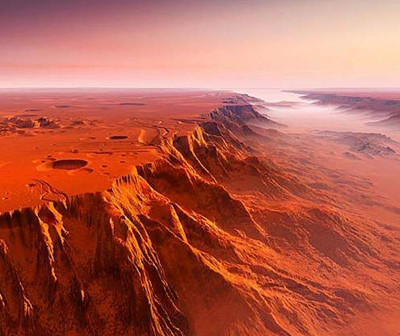If Martians exist, even the microbial sort, they probably need liquid water.
如果真有火星人,即使是微生物属,可能也需要液态水。
Temperatures on the surface of the red planet are below freezing, but signs exist that water flowed in the past—and perhaps still does, thanks to a Martian version of anti-freeze.
火星表面的温度在冰点以下,但是有迹象表明过去有水流动,也许现在仍然在流动,这一事实的发现多亏了火星版的防冻剂。
Salts lower the freezing point of water, as anyone knows who's thrown salt on an icy sidewalk.
盐可以降低了水的冰点,就如同大家所知的在结冰的人行道上撒盐是同一道理。
And both NASA's Phoenix and Curiosity missions found salts called perchlorates sprinkled around the Martian surface.
而美国航空航天局的凤凰号和好奇号航天器发现火星表面撒落的一种被称为高氯酸盐的盐分。

To see how perchlorates might act on Mars, researchers recreated the pressure, humidity and temperature of the planet inside a metal cylinder.
为了弄清楚高氯酸盐在火星上所起到的作用,研究人员在一个金属圆筒里重新模拟出火星的压力,湿度和温度。
They put a thin layer of perchlorates on top of water ice inside the chamber.
他们在这个容器内的冰面铺上了薄薄一层高氯酸盐。
Within minutes, droplets of liquid water formed, even at minus 100 degrees Fahrenheit.
即使在华氏零下100度,短短几分钟后就形成了液态水滴。
Some scientists thought perchlorates might condense water vapor from the atmosphere.
一些科学家认为高氯酸盐可能会凝结大气中的水蒸汽。
But within the cylinder, no liquid water formed in the presence of salts, either alone or on Mars-like soil, unless ice was present too.
但是在金属圆筒内,如果没有盐就不会形成液态水,而在火星土壤情况下也是如此,除非冰也参与这个过程。
The study is in the journal Geophysical Research Letters.
这项研究已经在《地球物理研究快报》杂志上发表。
The finding study could explain mysterious globules seen on the leg of the Phoenix in 2008.
这一研究发现可以解释2008年凤凰号航天器出现的神秘水珠。
The lander may have been dotted with drops of otherworldly water.
着陆器上可能沾上过几滴这种非现实世界的的水。


